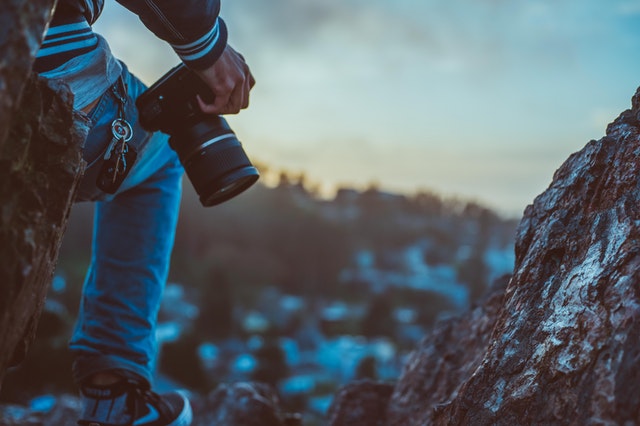
Photography businesses have changed drastically over the past decades and while in the beginning we were discussing digital photography as a new trend, this term has become obsolete as analogue photography is close to extinction and photography is over 95% digital.
This has given new opportunities to photographers to promote their work and expand their clients base, using professional portfolio websites and social media but has brought the challenge of copyright infringement and image theft along with it.
It is estimated that more than 2.5 billion images are stolen online daily. For photographers and image creators, digital copyright infringement is a cruel reality.
Unlike music and movies which are actively downloaded by the infringer logging on to peer-to-peer file sharing networks, all that is needed for photo infringement is a right click on an image found via an online search engine. This means that photo infringement is one of the easiest rights to breach, and what’s more, that infringers may be unaware that they are in fact breaching someone’s rights.
Obtaining copyright protection is one of the most valuable actions you can take to retain full control of your work, and make sure that you are paid your dues.
Firstly, what exactly is Copyright?
In a nutshell, Copyright law prohibits the unauthorized copying of a “work of authorship.” The types of work that are protected include pictorial, graphic, sculptural works, two-dimensional and three-dimensional works of fine, graphic, and applied art, photographs, prints and art reproductions, maps, globes, charts, diagrams, models, and technical drawings, including architectural plans.
If you are a photographer, copyright law says that “when you take a photograph, you automatically become the copyright owner of the image created. This means you hold exclusive rights to:
- Reproduce the photograph
- Display the image in a public space
- Distribute the photo
- Create derivatives of the image” (source: Professional Photographers of America)
And what about Derivatives and Fair Use?
Works that are already copyrighted and then produced as a ‘new version’ are deemed as ‘derivative’. Common examples of ‘derivative’ work include movies based on books, art reproductions, literary translations and even re-edits of movies.
For photographers, if a photo is “substantially similar” to another’s copyrighted work, potential infringement may be at play. A court of law can determine if violation of copyright laws have taken place.
Fair Use allows certain exceptions, which include journalism, non profit educational purposes and research, that allow reproduction of copyright-protected works without the permission of the original owner. So, if your photos are being displayed at a gallery, a newspaper promoting the event doesn’t typically need permission to publish photographs of works in their article.
According to U.S. Copyright Act the below are factors in considering Fair Use:
- The use is of commercial nature or if it is for nonprofit education purposes
- The copyrighted work is highly creative or if it is fact-based
- Part of the entire original work was reproduced or just a part of it
- The reproduction reduces the value of the original work or has no effect
You know how important it is to use social media like Instagram to promote your work and this is why you spend time researching the right photo to post and the proper photography hashtags to go along.
But did you know that images on Social media marketing campaigns are usually used without the original owner’s permission? If you suspect your work on social media platforms is being used without your knowing, visit CopyrightsWorld and learn more about how Social Protect can help you protect and monitor your original posts.
So, what steps can you take to legally protect your photos from being intentionally, or inadvertently, stolen online?
1. Get proof of ownership by registering your copyright
Another way to think about copyright protection is as insurance for your content, with worldwide coverage. It’s not mandatory to have, but being able to prove you are the original creator of your work gives you a winning advantage if you ever need to take your case to a court of law, and sets you up to be able to monetize your photographs.
2. Use a copyright notice
Displaying a copyright notice, such as ‘© All Rights Reserved,’ has not been a legal requirement in the US since 1989. It does, however, clearly identify you as the copyright holder, thereby decreasing the likelihood it will be used without authorization and bolstering legal evidence in the case that it is.
If your photo is used online without your consent, you can assume that the user knew that the photo was copyrighted. This is a very good example of how a copyright notice can help as evidence of ownership in case of legal dispute.
3. Use an active protection & monitoring service
Using a copyright protection and monitoring service like CopyrightsWorld can make the protection of your rights much easier and efficient. With a simple upload or hashtag you obtain indisputable evidence of copyright ownership and can monitor your files for global infringement, receiving reports when your rights are breached.
This way you can be certain that your rights as a creator are protected and spend more time creating more work, rather than worrying about how to protect it!
It’s interesting to note that the new creator economy is growing across all platforms and niches, and photography is one of them. In the USA alone, creators in 2017 earned a baseline of $6.8 billion on the nine top platforms, with the pandemic accelerating this shift. This trend towards the creators economy highlights the need for growing digital asset protection – creators and companies are now actively looking for ways to protect their content and monetize it.
Digital copyright protection seems to be becoming more prevalent, essential and mainstream as creators equip themselves for this new era.

